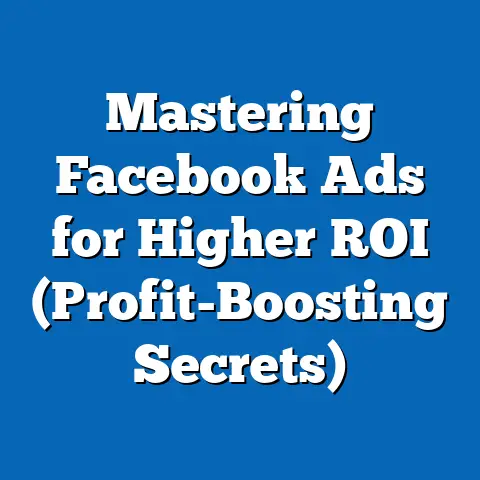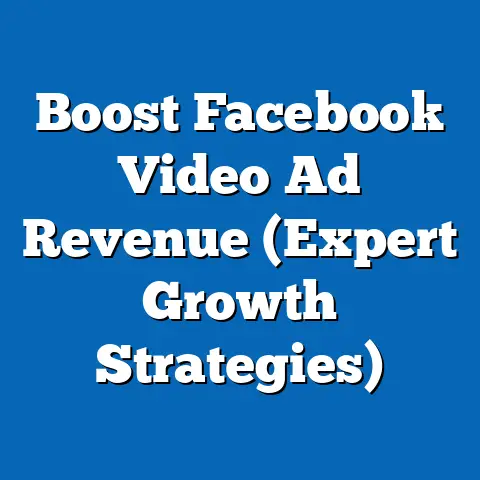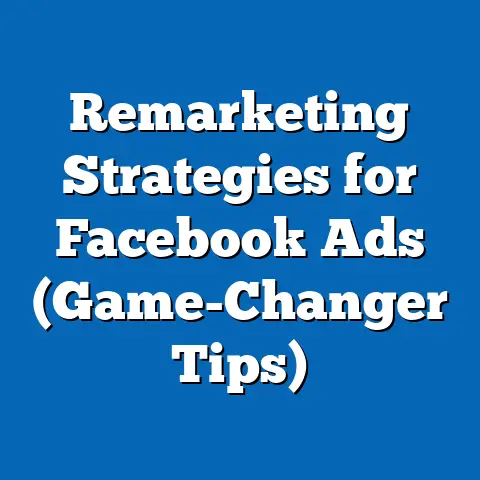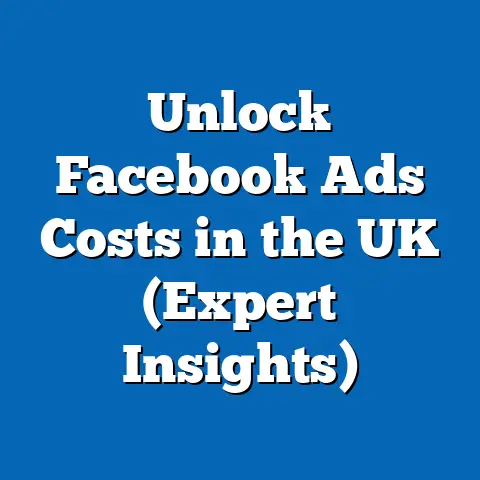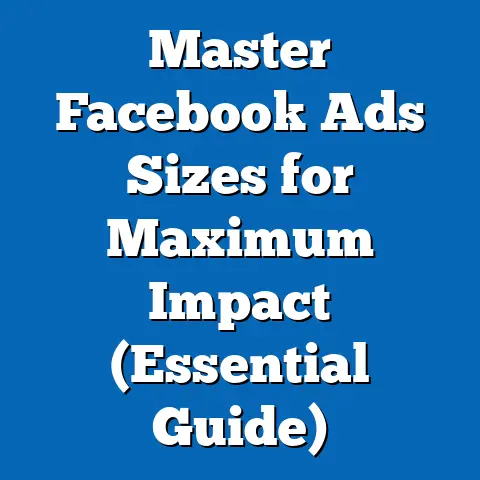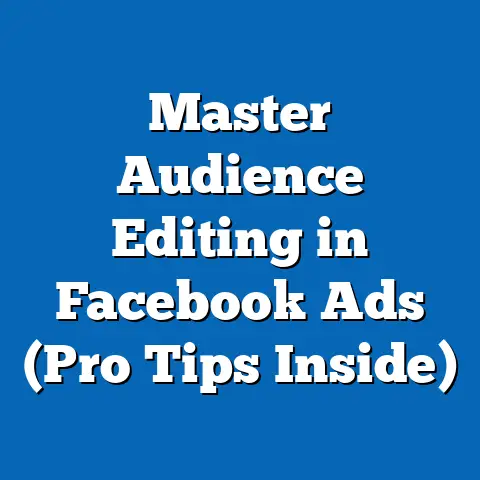Maximize ROI with Facebook & IG Ads (Proven Strategies)
As a digital marketing specialist, I’ve seen firsthand how powerful Facebook and Instagram can be for businesses of all sizes. But when it comes to luxury brands, the game changes. You’re not just selling a product; you’re selling an experience, a lifestyle, a status. This requires a sophisticated approach to Facebook and Instagram advertising, one that goes beyond basic targeting and generic creatives.
The luxury market presents unique challenges. High-end consumers are discerning, often skeptical of traditional advertising, and highly attuned to brand authenticity. They expect nothing less than perfection in every interaction, from the initial ad they see to the post-purchase experience. This means your Facebook and Instagram ads need to be impeccably crafted, precisely targeted, and seamlessly integrated with your overall brand story.
But the opportunities are immense. Facebook and Instagram boast massive user bases, including a significant segment of affluent consumers. With the right strategies, you can tap into this market, drive brand awareness, cultivate loyalty, and ultimately, maximize your return on investment (ROI).
My goal is to equip you with the knowledge and tools you need to create Facebook and Instagram ad campaigns that not only capture the attention of your target audience but also deliver a significant return on your investment. Let’s get started.
Section 1: Understanding the Luxury Market on Social Media
Before diving into the tactical aspects of Facebook and Instagram advertising, it’s crucial to understand the nuances of the luxury market and how it behaves on social media.
Defining the Luxury Market
The luxury market is characterized by high-quality products and services that offer exclusivity, craftsmanship, and a sense of prestige. These offerings are typically priced significantly higher than their mass-market counterparts and are often associated with aspirational lifestyles.
Luxury consumers are not just buying a product; they are buying an experience, a symbol of status, and a connection to a brand’s heritage and values. Their purchasing decisions are often driven by emotional factors, such as the desire for self-expression, social recognition, and a sense of belonging.
Demographics of Luxury Consumers on Facebook and Instagram
While it’s a common misconception that luxury consumers are only found in certain age groups or income brackets, the reality is more nuanced. On Facebook and Instagram, you’ll find affluent consumers across various demographics, each with their own unique interests and motivations.
- Age: While older generations still hold significant purchasing power, younger generations, particularly Millennials and Gen Z, are increasingly influencing the luxury market. They are digital natives who are highly active on social media and value authenticity and experiences over material possessions.
- Income: Naturally, income is a key factor in identifying luxury consumers. However, it’s important to consider that income levels vary significantly across different regions and countries.
- Interests: Luxury consumers are often passionate about travel, fashion, fine dining, art, culture, and philanthropy. They are also likely to be interested in high-end automobiles, real estate, and technology.
- Behaviors: Luxury consumers tend to be early adopters of new technologies and trends. They are also likely to be active participants in online communities and forums related to their interests.
Leveraging Visual Nature and Targeting Capabilities
Instagram’s visually driven platform is a natural fit for luxury brands. High-quality images and videos that showcase the craftsmanship, design, and lifestyle associated with your products can effectively capture the attention of affluent consumers.
Facebook’s robust targeting capabilities allow you to reach specific segments of the luxury market based on demographics, interests, behaviors, and even purchase history. This precision targeting ensures that your ads are seen by the people who are most likely to be interested in your brand.
Statistics and Case Studies
- A study by Deloitte found that digital channels influence approximately 50% of luxury purchases. This highlights the importance of having a strong online presence for luxury brands.
- According to Statista, the luxury goods market is expected to reach $380 billion by 2025, with online sales accounting for a significant portion of this growth.
- Case Study: Burberry: Burberry has successfully leveraged Instagram to showcase its latest collections and collaborations. By partnering with influencers and creating visually stunning content, they have been able to reach a younger, more digitally savvy audience.
Takeaway: Understanding the unique characteristics and demographics of the luxury market on social media is essential for developing effective Facebook and Instagram advertising strategies. By leveraging the visual nature of Instagram and the targeting capabilities of Facebook, you can reach affluent consumers and drive brand awareness.
Section 2: Crafting Irresistible Ad Creative
In the luxury market, your ad creative is your first impression. It’s the visual representation of your brand’s values, heritage, and commitment to quality. It needs to be captivating, aspirational, and perfectly aligned with your target audience’s expectations.
The Importance of High-Quality Visuals and Storytelling
Luxury consumers are accustomed to the finest things in life. They expect nothing less than perfection in every detail, including your ad visuals. High-quality images and videos are essential for showcasing the craftsmanship, design, and exclusivity of your products.
But visuals alone are not enough. You need to tell a story that resonates with your target audience’s emotions and aspirations. This could be a story about the brand’s history, the inspiration behind a particular product, or the lifestyle that your brand embodies.
Elements That Make Luxury Ads Enticing
- Exclusivity: Luxury consumers are drawn to products and experiences that are rare and unique. Highlight the limited availability or bespoke nature of your offerings.
- Craftsmanship: Showcase the skills and expertise that go into creating your products. Emphasize the use of high-quality materials and meticulous attention to detail.
- Lifestyle Imagery: Depict your products in aspirational settings that reflect the lifestyle of your target audience. This could be a luxurious vacation, a sophisticated dinner party, or a glamorous social event.
Examples of Successful Ad Creatives
- Chanel: Chanel’s ads often feature elegant models wearing their latest collections in stunning locations. The focus is on timeless style and understated luxury.
- Louis Vuitton: Louis Vuitton’s ads showcase the brand’s heritage and craftsmanship. They often feature close-up shots of their iconic bags and accessories, highlighting the quality of the materials and the attention to detail.
- Rolex: Rolex’s ads emphasize the precision and reliability of their watches. They often feature athletes and explorers wearing their watches in challenging environments, highlighting their durability and performance.
Creating Compelling Ad Copy
Your ad copy should be concise, elegant, and persuasive. It should focus on the benefits of your products and how they can enhance the lives of your target audience.
- Use evocative language: Appeal to the emotions and aspirations of your target audience.
- Highlight the exclusivity: Emphasize the limited availability or bespoke nature of your offerings.
- Focus on the experience: Describe the feeling of owning or using your products.
- Include a clear call to action: Tell your audience what you want them to do, whether it’s visiting your website, requesting a brochure, or making a purchase.
Takeaway: Creating irresistible ad creative is essential for capturing the attention of luxury consumers on Facebook and Instagram. Focus on high-quality visuals, compelling storytelling, and persuasive ad copy that resonates with your target audience’s emotions and aspirations.
Section 3: Targeting the Right Audience
Even the most beautiful ad creative will fall flat if it’s not seen by the right people. Facebook and Instagram offer a wealth of targeting options that allow you to reach specific segments of the luxury market with unparalleled precision.
Advanced Targeting Options
- Custom Audiences: Create custom audiences based on your existing customer data, such as email lists, website visitors, and app users. This allows you to retarget people who have already shown an interest in your brand.
- Lookalike Audiences: Expand your reach by creating lookalike audiences based on your custom audiences. Facebook will identify people who share similar characteristics and behaviors with your existing customers.
- Interest-Based Targeting: Target people based on their interests, hobbies, and passions. This allows you to reach people who are likely to be interested in your brand’s products or services.
- Behavior-Based Targeting: Target people based on their online behaviors, such as purchase history, travel habits, and device usage. This allows you to reach people who are actively seeking luxury goods and services.
- Demographic Targeting: Refine your targeting based on demographics such as age, gender, location, income, education, and relationship status.
Segmenting Your Audience
Luxury consumers are not a homogenous group. They have diverse interests, motivations, and purchasing habits. Segmenting your audience based on these factors allows you to tailor your ads to their specific needs and preferences.
- By Interest: Target people who are passionate about travel, fashion, fine dining, art, culture, or philanthropy.
- By Income: Target people who live in affluent neighborhoods or who have a history of purchasing luxury goods.
- By Behavior: Target people who frequently travel, dine at high-end restaurants, or attend exclusive events.
- By Lifestyle: Target people who lead active, sophisticated, or adventurous lifestyles.
Understanding the Customer Journey
The customer journey for luxury goods is often complex and involves multiple touchpoints. Understanding this journey allows you to tailor your ads to each stage of the process.
- Awareness: Create ads that introduce your brand and its values to potential customers.
- Consideration: Create ads that showcase the benefits of your products and how they can enhance the lives of your target audience.
- Decision: Create ads that offer exclusive deals or incentives to encourage potential customers to make a purchase.
- Loyalty: Create ads that reward your existing customers and encourage them to become brand advocates.
Retargeting Strategies
Retargeting allows you to re-engage potential customers who have already shown an interest in your brand. This is a highly effective strategy for driving conversions and maximizing ROI.
- Website Retargeting: Retarget people who have visited your website but haven’t made a purchase.
- Product Page Retargeting: Retarget people who have viewed specific product pages on your website.
- Cart Abandonment Retargeting: Retarget people who have added items to their cart but haven’t completed the checkout process.
- Video Retargeting: Retarget people who have watched your videos on Facebook or Instagram.
Takeaway: Targeting the right audience is crucial for the success of your Facebook and Instagram advertising campaigns. By leveraging the platform’s advanced targeting options and segmenting your audience, you can reach the people who are most likely to be interested in your brand and its products.
Section 4: Leveraging Facebook and Instagram Features
Facebook and Instagram offer a variety of ad formats and features that can be used to effectively reach and engage luxury consumers.
Ad Formats
- Stories Ads: Stories ads are full-screen, vertical videos or images that appear between users’ stories. They are highly engaging and can be used to showcase your brand’s personality and values. For luxury brands, I’ve found success using behind-the-scenes footage, influencer collaborations, and quick glimpses of new collections.
- Carousel Ads: Carousel ads allow you to showcase multiple images or videos in a single ad. This is a great way to highlight different features of your products or tell a story about your brand. I once ran a carousel ad for a luxury watch brand, showcasing the intricate details of the watch’s movement and craftsmanship. The engagement was significantly higher than single-image ads.
- Collection Ads: Collection ads are designed for e-commerce businesses and allow you to showcase a collection of products in a visually appealing format. This is a great way to drive traffic to your website and increase sales.
- Video Ads: Video ads are highly engaging and can be used to tell a story about your brand, showcase your products, or demonstrate their functionality.
- Image Ads: Image ads are the simplest ad format and can be used to create visually appealing and informative ads.
Instagram Shopping and Facebook Shops
Instagram Shopping and Facebook Shops allow you to sell your products directly on the platforms. This is a convenient way for customers to make purchases without leaving the app. For luxury brands, this can be a double-edged sword. While it offers convenience, it’s crucial to maintain the luxury experience within the platform. High-quality product images, detailed descriptions, and a seamless checkout process are essential.
Influencers and Brand Ambassadors
Influencers and brand ambassadors can be powerful tools for reaching luxury consumers on social media. By partnering with influencers who align with your brand’s values and target audience, you can tap into their existing followers and build trust and credibility.
- Micro-Influencers: Micro-influencers have smaller, more engaged audiences and can be a cost-effective way to reach niche markets.
- Macro-Influencers: Macro-influencers have larger audiences and can be used to drive brand awareness and reach a wider audience.
- Brand Ambassadors: Brand ambassadors are long-term partners who represent your brand and its values.
Examples of Successful Integrations
- Dior: Dior has successfully integrated Instagram Shopping into its advertising strategy, allowing customers to purchase its products directly from its Instagram feed.
- Gucci: Gucci has partnered with a variety of influencers to promote its products on social media, including fashion bloggers, celebrities, and artists.
- Mercedes-Benz: Mercedes-Benz has used Facebook Shops to showcase its latest models and allow customers to schedule test drives.
Takeaway: Facebook and Instagram offer a variety of ad formats and features that can be used to effectively reach and engage luxury consumers. By leveraging these features, you can create compelling advertising campaigns that drive brand awareness, increase sales, and maximize ROI.
Section 5: Measuring and Optimizing Performance
Measuring and optimizing the performance of your Facebook and Instagram ad campaigns is essential for maximizing ROI. Without tracking the right metrics and making data-driven adjustments, you’re essentially flying blind.
Key Performance Indicators (KPIs)
- Reach: The number of unique people who saw your ad.
- Impressions: The number of times your ad was displayed.
- Engagement: The number of likes, comments, shares, and clicks your ad received.
- Click-Through Rate (CTR): The percentage of people who clicked on your ad after seeing it.
- Cost Per Click (CPC): The average cost you paid for each click on your ad.
- Conversion Rate: The percentage of people who completed a desired action, such as making a purchase or filling out a form, after clicking on your ad.
- Cost Per Acquisition (CPA): The average cost you paid to acquire a new customer through your ad campaign.
- Return on Ad Spend (ROAS): The amount of revenue you generated for every dollar you spent on advertising.
For luxury brands, it’s important to also track metrics that indicate brand perception and engagement quality, such as:
- Comment Sentiment: Analyze the sentiment of comments on your ads to gauge how people are reacting to your brand and products.
- Video Completion Rate: Track how many people are watching your videos to completion. This indicates the level of engagement with your brand’s storytelling.
- Website Time on Page: Monitor how long people are spending on your website after clicking on your ad. This indicates the level of interest in your products and services.
Facebook Ads Manager and Insights
Facebook Ads Manager and Insights provide a wealth of data about your ad campaigns, including performance metrics, audience demographics, and ad creative performance. By analyzing this data, you can identify areas for improvement and optimize your campaigns for better results.
- Performance Metrics: Track your KPIs over time to identify trends and patterns.
- Audience Demographics: Analyze the demographics of the people who are engaging with your ads to refine your targeting.
- Ad Creative Performance: Compare the performance of different ad creatives to identify what resonates best with your target audience.
A/B Testing
A/B testing involves creating two or more versions of an ad and testing them against each other to see which one performs better. This is a highly effective way to optimize your ad creative and audience targeting.
- Ad Creative A/B Testing: Test different headlines, images, videos, and calls to action to see which ones generate the most engagement.
- Audience Targeting A/B Testing: Test different targeting options to see which ones reach the most relevant audience.
Continuous Learning and Adaptation
The digital advertising landscape is constantly evolving. New features, trends, and best practices emerge regularly. It’s important to stay up-to-date on these changes and adapt your advertising strategies accordingly.
- Follow Industry Blogs and Publications: Stay informed about the latest trends and best practices in digital advertising.
- Attend Industry Conferences and Webinars: Network with other marketers and learn from industry experts.
- Experiment with New Features and Technologies: Be willing to try new things and see what works for your brand.
Takeaway: Measuring and optimizing the performance of your Facebook and Instagram ad campaigns is essential for maximizing ROI. By tracking the right metrics, analyzing data, and A/B testing, you can continuously improve your campaigns and achieve better results.
Section 6: Real-Life Case Studies of Successful Luxury Ads
Let’s explore some real-world examples of luxury brands that have effectively used Facebook and Instagram ads to achieve their marketing goals.
Case Study 1: Tag Heuer – Driving Awareness and Engagement
Brand: Tag Heuer, a luxury watchmaker.
Objective: Increase brand awareness and engagement among a younger audience.
Strategy: Tag Heuer partnered with Formula 1 drivers and influencers to create a series of short, engaging video ads showcasing their watches in action. They used Facebook and Instagram Stories to distribute the ads, targeting a younger demographic interested in motorsports and luxury goods.
Creative Execution: The ads featured fast-paced visuals, upbeat music, and authentic interactions with the brand’s ambassadors. The copy highlighted the brand’s heritage and connection to the world of racing.
Results:
- Significant increase in brand awareness among the target audience.
- High engagement rates on the video ads, with a large number of likes, comments, and shares.
- Increased website traffic and social media followers.
Lessons Learned:
- Partnering with relevant influencers can be a powerful way to reach a younger audience.
- Short, engaging video ads are highly effective on Facebook and Instagram Stories.
- Authenticity and storytelling are key to resonating with luxury consumers.
Case Study 2: Four Seasons Hotels – Driving Bookings and Revenue
Brand: Four Seasons Hotels, a luxury hotel chain.
Objective: Increase bookings and revenue at their resorts.
Strategy: Four Seasons used Facebook and Instagram ads to target affluent travelers interested in luxury vacations. They created visually stunning ads showcasing their resorts, highlighting the amenities, activities, and experiences they offer. They used retargeting to reach people who had previously visited their website or expressed interest in their hotels.
Creative Execution: The ads featured high-quality images and videos of their resorts, showcasing the beautiful scenery, luxurious accommodations, and unique experiences they offer. The copy emphasized the exclusivity and personalized service that Four Seasons is known for.
Results:
- Significant increase in bookings and revenue at their resorts.
- High conversion rates on the ads, with a large number of people clicking through to their website and making reservations.
- Increased brand awareness and positive brand perception.
Lessons Learned:
- Visually stunning ads are essential for attracting luxury travelers.
- Highlighting the unique amenities, activities, and experiences your brand offers can be highly effective.
- Retargeting is a powerful tool for driving conversions.
Case Study 3: BMW – Generating Leads and Test Drives
Brand: BMW, a luxury automobile manufacturer.
Objective: Generate leads and drive test drives at their dealerships.
Strategy: BMW used Facebook and Instagram ads to target affluent consumers interested in luxury cars. They created ads showcasing their latest models, highlighting the performance, technology, and design of their vehicles. They used Facebook Lead Ads to collect contact information from interested consumers and offered incentives for scheduling a test drive.
Creative Execution: The ads featured sleek, dynamic images and videos of their cars, showcasing their performance and technology. The copy emphasized the driving experience and the prestige of owning a BMW.
Results:
- Significant increase in leads and test drives at their dealerships.
- High conversion rates on the lead ads, with a large number of people providing their contact information.
- Increased brand awareness and positive brand perception.
Lessons Learned:
- Showcasing the performance, technology, and design of your products can be highly effective.
- Offering incentives for taking action can drive conversions.
- Facebook Lead Ads are a convenient way to collect contact information from interested consumers.
Takeaway: These case studies demonstrate that luxury brands can successfully maximize their ROI through Facebook and Instagram ads by implementing targeted strategies, creating compelling ad creative, and leveraging the platform’s features.
By implementing these strategies, luxury brands can significantly enhance their ROI on Facebook and Instagram and achieve their marketing goals. However, the digital advertising landscape is constantly evolving. It’s important to stay ahead of trends, continuously innovate your approach, and adapt your strategies to the changing needs and preferences of your target audience.
Remember, luxury advertising is not just about selling a product; it’s about selling an experience, a lifestyle, and a status. By creating compelling advertising campaigns that resonate with the emotions and aspirations of your target audience, you can build brand awareness, cultivate loyalty, and ultimately, maximize your return on investment.
As you embark on your Facebook and Instagram advertising journey, remember that the key to success is to be authentic, creative, and data-driven. By staying true to your brand’s values, continuously experimenting with new ideas, and closely monitoring your results, you can achieve remarkable success and establish your brand as a leader in the luxury market.
The future of digital advertising in the luxury sector is bright, and I encourage you to embrace the opportunities that Facebook and Instagram offer. By implementing the strategies discussed in this guide and staying ahead of trends, you can unlock the full potential of these platforms and achieve unprecedented success. Good luck!

